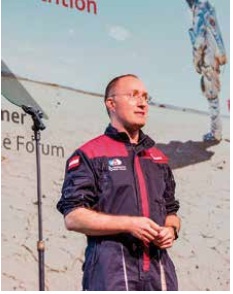Demand for animal protein will keep growing despite market turbulence driven by radically changing eating habits of millennials, public health concerns and greater acceptance of plant-based protein sources.
In a presentation at the World Nutrition Forum hosted by Biomin, David Hughes, emeritus  professor of food marketing at Imperial College London, predicted that poultry and fish will be the top protein choices in the future.
professor of food marketing at Imperial College London, predicted that poultry and fish will be the top protein choices in the future.
Beef, he added, is “in the firing line” due to greenhouse gas emissions from rumen-based digestion. Citing National Geographic magazine, he claimed that it takes 1,800 gallons of fresh water to pro- duce one pound of beef.
“This is not in tune with customers who prefer environmental friendly products,” said Prof. Hughes.
In the 1950’s, beef was the top choice. But now beef consumption in Great Britain and France has plummeted due to reasons related to health, economic and environmental concerns.
Sanitary standards must be raised in the meat industry. Even though food pro- ducers and animal protein processors may not be able to extract a premium for keeping up with more rigorous require- ments, they will pay a steep price if they are unable to keep up with the changing rules.
Is meat a super profitable ride forward?
Planet Earth has the capacity to feed the current 7.4 billion people and can accom- modate another two billion humans, how- ever, the issue is whether producers will do it in a sustainable way or otherwise, he said.
Increasing urbanization is the most effective birth control method ever devised, he added, because it is simply too expensive to have a lot of children in an urban setting.
On the other hand, declining populations in some countries such as Japan are forcing investors to aggressively target bur- geoning offshore markets or acquire other companies.
“From here on in, Japan will lose one million people a year. That is why food retailers see vaporizing profits,” he said.
China will slowly lose its leading role in driving global market demand for protein.
By 2030, China will be an aging society similar to Japan. But there will be huge implications for social and health issues due to the sheer size of the population.
By and large, global demand for meat is still going strong. However, growth will be driven by emerging economies.
Eating habits will change as populations grow older. Old people eat less meat and more fruit and vegetables.
Current robust protein demand is the result of growing populations and higher incomes. The global market, however, will remain volatile due to changing con- sumer preferences.
Swine will face challenges from poultry and fish because they are more efficient to produce. For example, the feed conversion ratio of tilapia and pangasius is around 1.0 and poultry below 1.5.
Protein going beyond meat
Animal protein consumption is taking a hit due to the rising number of “flexitar- ian” or semi-vegetarian consumers who prefer a plant-based diet with occasional inclusion of meat products.
Plant-based “Beyond Burger” and other companies such as Just Mayo – an egg- less spread made by Hampton Creek – are elbowing their way into the market for animal protein. More companies in this segment are set to emerge. One of the world’s largest dairy companies – Danone – last July spent $12.5 billion to acquire plant-based dairy businesses.
Analog protein is gaining acceptance because of its taste, not because consum- ers do not like meat anymore. Customers are looking for healthy, environmentally friendly and tasty alternatives.
Myco-protein mimics chicken, and insect protein is starting to carve out a niche in human food and livestock feed.
Food retailing
Supermarkets in the UK have begun offering meal-based solutions. Consumers either buy the complete meal or components of meals and put them together at home. More and more retail- ers are competing in this market because it offers their customers good food and good value, he said.
Food retailers, food services, and restarants, both eating out and eating in, are all converging into the same thing, he added.
With increasing complexity in food, the food supply chain and purchasing behav- ior, consumers are looking at more than price and value. They are also keen to know about the social and environmental impact of food production,
Customers are looking for special attri- butes. For example, free-range chickens fed herbs and cereals rich in Omega 3 raised by artisan farmers could fetch up to USD$23/kg at premium retailers in the UK – a spectacular premium advan- tage over industrial broilers. This trend shows that producers who are able to “add adjectives” are able to reap much higher margins, he said.
Consumers are willing to pay more for products laden with attributes such as free-range, hormone-free, antibiotic-free and more that differentiate them from conventional products.
Natural free-range, herb-fed pork is dif- ferent from commodity pork in many aspects. The more adjectives added to the product description, the higher the profit margin gained.
Products free of antibiotics, hormones, E. coli, GMO, gluten, and anything pro- duced in a more natural, amicable way are unstoppable, he said.
On the flip side, such demands create greater opportunities for fraud because the rewards are tempting and cheating is easy. More deceitful claims can be expected.
Millennial consumers don’t eat three square meals a day. Instead, they may opt for mini-meals, replace some meals with snacks, or live on snacks through- out the day.
Consumers are keen to learn more about the health effects and social aspects of food production, but they also prefer time-saving alternatives to cooking at home. They may eat out, search for reci- pes online, or buy meal kits rather than a single ingredient.
Pressure to reduce meat consumption is underway. For example, Holland’s new dietary guidelines urge consumers to cut meat consumption to just 460 grams/per- son/week. Plant-based protein sources are stealing market share formerly held by animal protein.
 Adrian Moss, of Focus business Communication in the UK, highlighted the growing influence of online communication and social media. In a crisis, he said, a quick and appropriate response can save a brand and a business.
Adrian Moss, of Focus business Communication in the UK, highlighted the growing influence of online communication and social media. In a crisis, he said, a quick and appropriate response can save a brand and a business.
“Acknowledge public relations issues, explain what you are doing as a company. Communicate with the public, provide and update information regularly and be consistent. Engage in social media. Build a group of loyal fans and followers as they can be your eyes and ears in supporting you in a crisis situation,” said Mr Moss.
“When faced with issues, confront them. Don’t blame others, beware of delegating tasks to junior staff. Make sure the crisis is taken care of by the most senior staff in your organization because it could mean the future of your organization going forward.”
Colonizing the Red Planet
 Dr Gernot Gromer, of the Austria Space Forum, talked about growing food crops in space and progress in Mars exploration. He claimed that a human Mars expe-dition is likely within the next decade.
Dr Gernot Gromer, of the Austria Space Forum, talked about growing food crops in space and progress in Mars exploration. He claimed that a human Mars expe-dition is likely within the next decade.
Scientists are intrigued by Mars because it is believed that four billion years ago it was very similar to the Earth. Despite the daunting challenges of distance and the extreme and barren environment, sci- entists are studying ways to stay healthy during a long space journey in a self-sus- tained environment and the viability of farming on the Red Planet.
Scientists at Wageningen University in the Netherlands have successfully grown vegetables in soil compositions similar to those found on Mars and the Moon. Despite low yields, the crops are safe to eat.
The International Potato Centre in Peru is screening over 4,500 potato varieties and found 100 viable specimens with good resilience that thrive despite drought and extreme temperatures.
Beihang University in Beijing success- fully conducted a 105-day experiment in a closed biosphere where three volun- teers lived in 500-cu-m “spaceship.”
The self-contained capsule, or “biore- generative life-support base,”
contained living quarters and plant cul- tivation modules for growing corn, pea- nuts and vegetables. Human waste and food residues were recycled and used as plant fertilizer.
The Austria Space Forum also simulated a mission to Mars with six people living in a closed system in the northern Sahara desert in Morocco. The region was chosen for its similarity to Mars in order to study and design new technologies to accommodate space expeditions.
